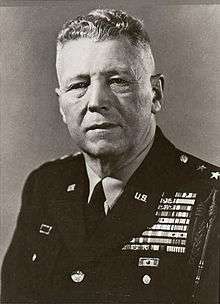Bruce C. Clarke
| Bruce C. Clarke | |
|---|---|
 General Bruce C. Clarke | |
| Born |
April 29, 1901 Adams, New York |
| Died | March 17, 1988 (aged 86) |
| Buried at | Arlington National Cemetery |
| Allegiance |
|
| Service/branch |
|
| Years of service |
1917–1921 1925–1962 |
| Rank |
General |
| Commands held |
Continental Army Command U.S. Army Europe U.S. Army, Pacific I Corps X Corps First Republic of Korea Army 1st Armored Division |
| Battles/wars |
World War I World War II Korean War |
| Awards |
Distinguished Service Cross Army Distinguished Service Medal (3) Silver Star (3) Legion of Merit Bronze Star (3) with "V" Device Air Medal Army Commendation Medal |
Bruce Cooper Clarke was a United States Army general. He was a career officer who served in World War I, World War II, and the Korean War. He was the commander of Continental Army Command from 1958–1960, Commander, U.S. Army Europe from 1960-1962, and commanded the U.S. Army, Pacific from December 1954 to April 1956.
Biography
Clarke was born on a farm in Adams, New York, on April 29, 1901. He dropped out of high school to enlist in the Army in 1917, and gained appointment to the United States Military Academy through the New York National Guard. He graduated in 1925 with a commission in the Corps of Engineers. In addition to his degree from West Point, he earned a civil engineering degree from Cornell University and an LLB from La Salle Extension University.[1] He also was an equivalent graduate of the National War College and is credited with starting the Non-Commissioned Officers Academy system. From 1958-1960 he commanded the Continental Army Command, heading the entire Army school system which, at the time, had over 250,000 participants.
During World War I, Clarke served in the Coast Artillery Corps. In the Second World War, as a colonel and then a brigadier general, he commanded Combat Command A (CCA) of the U.S. 4th Armored Division in Gen. George S. Patton's Third Army, leading it to victory over a superior German armored force at the Battle of Arracourt in September 1944. In December Clarke led the relief of St. Vith during the Battle of the Bulge, which slowed the German attack. Writing afterward, General Eisenhower credited Clarke's actions as the "turning point" in that battle.
During the Korean War, General Clarke commanded the I Corps and the X Corps. He also trained the First Republic of Korea Army.
Peacetime major commands for General Clarke include Commanding General of the 1st Armored Division, Fort Hood, Texas, from 1951-1953. After his tour in Hawaii he commanded the Seventh United States Army in Germany. He received a promotion to the rank of four-star general in August 1958. From 1960–1962 he served as Commander in Chief of US Army, Europe before retiring on April 30, 1962.
He and his wife, Bessie, had three sons and one daughter.
On October 18, 1971 The Supreme Council of the Scottish Rite for the Southern Jurisdiction of the United States conferred upon Clarke, 33 degree, U.S. Army Ret., the Grand Cross of the Court of Honor.
This is the highest Masonic award, with only 11 holders out of 600,000 members in the Scottish Rite in that Jurisdiction.
Military decorations
Clarke's U.S. military decorations include the Distinguished Service Cross, three Army Distinguished Service Medals, three Silver Stars, the Legion of Merit, and three Bronze Stars. He also received decorations from foreign countries including France, Germany, Great Britain, Korea, and the Philippines.
 Distinguished Service Cross
Distinguished Service Cross Army Distinguished Service Medal with two oak leaf clusters
Army Distinguished Service Medal with two oak leaf clusters Silver Star with two oak leaf clusters
Silver Star with two oak leaf clusters Legion of Merit
Legion of Merit Bronze Star with two oak leaf clusters and "V" Device
Bronze Star with two oak leaf clusters and "V" Device Air Medal
Air Medal Army Commendation Medal
Army Commendation Medal
Death and burial
Clarke died on March 17, 1988 and was buried with full military honors in Section 7-A (Grave 130) at Arlington National Cemetery. His wife, Bessie Mitchell Clarke, is buried with him.
See also
- List of United States Army four-star generals
- List of recipients of the Silver Buffalo Award
- List of lieutenant generals in the United States Army before 1960
- List of La Salle Extension University people
- List of commanders of I Corps (United States)
References
![]() This article incorporates public domain material from the United States Government document "".
This article incorporates public domain material from the United States Government document "".
- ↑ Military Government Association (1958). Military government journal, Volume 10.
| Military offices | ||
|---|---|---|
| Preceded by Clyde D. Eddleman |
Commanding General of U.S. Army Europe October 20, 1960 to May 1, 1962 |
Succeeded by Paul L. Freeman, Jr. |
| Preceded by Clyde D. Eddleman |
Commanding General of the Seventh United States Army April 1, 1959 to October 20, 1960 |
Succeeded by Francis William Farrell |